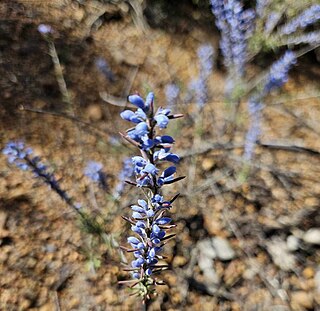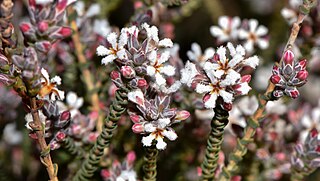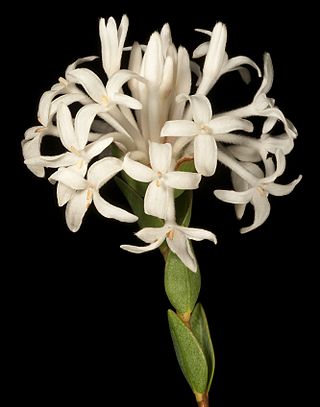
Grevillea umbellulata is species of flowering plant in the family Proteaceae and is endemic to the south-west of Western Australia. It is a spreading shrub that forms a lignotuber, has linear to narrowly elliptic leaves, and cylindrical clusters of hairy, white to cream-coloured flowers often tinged with grey or pink.

Grevillea teretifolia, commonly known as round leaf grevillea, is species of flowering plant in the family Proteaceae and is endemic to the southwest of Western Australia. It is an erect to spreading shrub with many stems, divided leaves, the end lobes sharply pointed and more or less cylindrical, and clusters of white or pale pink flowers.

Conospermum amoenum, commonly known as blue smokebush, is a species of flowering plant in the family Proteaceae and is endemic to the south-west of Western Australia. It is an erect or spreading shrub with linear leaves, and spikes of blue or white tube-shaped flowers.

Conospermum bracteosum is a species of flowering plant in the family Proteaceae and is endemic to the south-west of Western Australia. It is an erect, spindly shrub with egg-shaped leaves, sometimes with the narrower end towards the base, and spikes of silky, woolly, tube-shaped white flowers.

Leucopogon sprengelioides is a species of flowering plant in the family Ericaceae, and is endemic to the south-west of Western Australia. It is an erect shrub with stem-clasping, egg-shaped or lance-shaped leaves and short, dense spikes of white, tube-shaped flowers.

Gompholobium ovatum is a species of flowering plant in the family Fabaceae and is endemic to the south-west of Western Australia. It is an erect or prostrate shrub with egg-shaped leaves and yellow and red to purple, pea-like flowers.

Gompholobium preissii is a species of flowering plant in the family Fabaceae and is endemic to the south-west of Western Australia. It is an erect shrub with pinnate leaves with five to fifteen leaflets, and yellow, red and orange, pea-like flowers.

Gompholobium shuttleworthii is a species of flowering plant in the pea family Fabaceae and is endemic to the south-west of Western Australia. It is an erect shrub with pinnate leaves with five to nine leaflets, and pink or purple flowers with some darker markings.

Gompholobium villosum is a species of flowering plant in the pea family Fabaceae and is endemic to the south-west of Western Australia. It is a slender, erect shrub with simple, needle-shaped leaves with one or two grooves on the lower surface, and violet, pink or purple flowers.
Pultenaea strobilifera is a species of flowering plant in the family Fabaceae and is endemic to the south-west of Western Australia. It is an open to dense, domed or spindly, erect shrub with simple leaves and yellow-orange and salmon pink to bright pink flowers.
Gompholobium viscidulum is a species of flowering plant in the pea family Fabaceae and is endemic to the south-west of Western Australia. It is an erect shrub with pinnate leaves with five to seven leaflets, and yellow flowers.

Thomasia cognata is a species of flowering plant in the family Malvaceae and is endemic to the south-west of Western Australia. It is a compact, multi-stemmed shrub with wrinkled, narrowly oblong to elliptic leaves and pale pink flowers.
Thomasia discolor is a species of flowering plant in the family Malvaceae and is endemic to the south-west of Western Australia. It is a small, compact shrub with hairy new growth, heart-shaped leaves with wavy, lobed edges, and pink flowers in crowded clusters.
Cryptandra nutans is a species of flowering plant in the family Rhamnaceae and is endemic to the southwest of Western Australia. It is a shrub that typically grows to a height of 10–60 cm (3.9–23.6 in) and has many stems at ground level. Its leaves are up to 4 mm (0.16 in) long, and the flowers are white, pink or cream-coloured and crowded in spikes on the ends of branches. The sepals are joined at the base to form a broadly bell-shaped tube, less than 2 mm (0.079 in) long with spreading lobes. Flowering occurs in August and September. It was first formally described in 1845 by Ernst Gottlieb von Steudel in Lehmann's Plantae Preissianae from specimens collected in 1840. The specific epithet (nutans) means "nodding".

Conostephium preissii is a species of flowering plant in the family Ericaceae and is endemic to the southwest of Western Australia. It is an erect shrub with many stems, egg-shaped to oblong leaves and white and purplish to reddish-pink flowers.

Pimelea preissii is a species of flowering plant in the family Thymelaeaceae and is endemic to the southwest of Western Australia. It is an erect, spreading shrub with narrowly elliptic leaves arranged in opposite pairs, and compact clusters of many white or pink flowers surrounded by 4 green, egg-shaped involucral bracts.

Chorizema carinatum is a species of flowering plant in the family Fabaceae and is endemic to the southwest of Western Australia. It is an erect or spreading shrub with sharply-pointed leaves and bright yellow flowers.
Chorizema racemosum is a species of flowering plant in the family Fabaceae and is endemic to the southwest of Western Australia. It is a spreading or erect shrub with leathery, linear leaves, and yellowish-orange and red pea flowers.
Chorizema rhynchotropis is a species of flowering plant in the family Fabaceae and is endemic to the southwest of Western Australia. It is a straggling, sprawling or erect shrub with linear, sharply-pointed leaves, and orange or red and pink and yellow pea flowers.

Chorizema spathulatum is a species of flowering plant in the family Fabaceae and is endemic to the southwest of Western Australia. It is an erect or low-lying shrub with linear to wedge-shaped or almost oblong leaves, and yellow pea flowers.














